HiFiMAN HM-802 Portable High Resolution Music Player Review Highlights
HiFiMAN is probably best known for their headphones and headphone amplifiers, some of which we have reviewed, but they also manufacture portable music players, as an alternative to the ubiqutious iPod. The HM-802 is one of several models, including the HM-700, which is less expensive than the HM-802, and the HM-901, which is more expensive.
You also have the option of having a balanced amplifier module in the player or the standard unbalanced one. In this review, I cover the model HM-802, with the standard unbalanced amplifier module. It plays PCM music tracks up to 24/192 and DSD64, as well as wav, flac, mp3, alac, aac, and aiff files.
Portable music players have traditionally played mp3 music files, which is a lossy compressed format, because the amount of memory was limited. They also did not play anything above 16/44.1 sampling.
When players with more than 100 GB of memory became available, using uncompressed 16/44.1 wav files was manageable. So, we could listen to the sound in the same quality as the original CD.
In the past few years, a large number of websites began offering downloadable music in higher resolution than 16/44.1. Much of the music is taken from analog tapes that were recorded in the 1950's, '60's, '70's, and '80's. That represents a huge catalog of music that was on all that vinyl that we tossed away when digital CD's hit the market.
Not only have thousands of classic albums become available as downloads, they are available in higher resolution, such as 24/96 and 24/192 PCM, as well as DSD64, which is the codec for SACD. Although even higher resolution music can be downloaded, incuding 24/352.8 PCM and DSD128, those resolutions are only produced by one website (2L).
The HiFIMAN HM-802 will play music files upt to 24/192 PCM and DSD64.
It uses an SD card for memory (not included), so I purchased a 128GB SD card and placed it in my memory card reader, then dragged and dropped music files onto the card, then placed it in the HM-802 card slot.
Unlike an iPod, the HM-802 can drive full sized headphones, such as the HE-500's, which I reviewed some time ago.
Navigation through my music files was done by using the "SD Card" menu, which one of several selections on the front LCD panel.
The sound quality was vastly improved over what I was used to with my iPod, not only because the DAC (Wolfson) is of a higher quality than in an iPod, but also because of the higher resolution in many of my albums that I have downloaded.
HiFiMAN HM-802 Portable High Resolution Music Player Review Highlights Summary
• Can drive full sized headphones
• Plays high resolution music files
• Excellent sound quality
• Replaceable battery
• Upgradable to balanced amplifier card
Introduction to the HiFiMAN HM-802 Portable High Resolution Music Player Review
When one used to refer to his/her "portable music player", the term iPod was what they said, because that was all there was. Then came iPhones and iPads, both of which can contain your music, and it can be played from those two devices. You have to use iTunes to manage your music and it is limited to 16/44.1 sampling, either as wav or Apple Lossless compression.
In spite of being able to store and play your music on the iPod, iPhone, and iPad in lossless format, it appears that most users still store their music in the lossy mp3 format. I really don't understand this, but that's the way it is. I know some audiophiles who still use mp3 to put their music on their i-devices.
Perhaps the reason has something to do with the fact that earbuds are the standard for listening to their music on these devices.
Over the past several years, full sized headphones (over-the-ear) have exploded onto the music scene. Apple purchased Beats in June, a company that makes very popular headphones, for $3 billion. They are also rumored to be developing a proprietary headphone connection on their i-devices.
HiFiMAN markets three models of portable players, the HM-700, HM-802 (reviewed here), and the HM-901, in increasing order of price. They are all available in balanced amplifier circuitry (optional - about $300 extgra), but you need to get the balanced cable that fits your headphones and the 3.5mm balanced headphone jack on the HiFiMAN players, which is 3.5mm. There are several balanced headphone jacks emerging on players: 4 pin XLR, 3.5mm, and 2.5mm. Apple may develop yet another size jack for their newly acquired Beats headphone line. I think it is really sad that the balanced headphone jack wil be in so many variations. This is a huge disservice to the consumer. The only way to beat it is to purchase the same brand of headphone as the headphone amplifier and portable music player.
The Design of the HiFiMAN HM-802 Portble Music Player
The HM-802 comes with a single-ended amplifier card installed as standard.
A photo of the inside of the chassis is shown below. The battery, also seen in the photo, is large, which allows it to drive a full sized pair of headphones. The standard amp card is shown inside the chassis at the top. The battery is on the right.
You can replace the battery when needed, and also upgrade to the balanced amp card. The unbalanced card is removed and the balanced one is inserted. I received a balanced amp card and the balanced cable just this week, so I will append the review when I finish testing the HM-802 in balanced mode. I decided to proceed with the review of the unbalanced amp card version so as not to delay publication.
The HiFiMAN HM-802 Portble Music Player In Use
The first thing you have to do is get a high capacity SD card. I found a 128 GB card on Amazon for $79. This won't hold all of my music, but it will hold my favorite albums, including high resolution downloaded albums.
Use a memory card reader attached to your computer to load the music, as this avoids problems that otherwise occur by interfacing with the player rather than the card directly.
The SD card is inserted on the side of the player by opening a flap and pushing it in until it clicks into place.
Also, as with other products that use rechargable batteries, charge the battery in the HM-802 by plugging the included cable into a USB jack on your computer. The other end of this cable has a proprietary multi-pin connector that fits into a jack on the bottom end of the player.
Buttons on the right side of the player allow for power on/off, selecting high defintion, gain, and locking the player so you can't accidentally activate one of the buttons on the front of the player if you have it in your pocket. The left side of the player has the SD card slot and a switch to select balanced or unbalanced operation.
The main controls are on the front, with an LCD display that shows your music files in various ways, such as "Now Playing", "Favorite", "SD Card", "Artist", "Album", "Genre", "All Songs", and "Settings". However, if you have stored your music without the metadata, using anything other than "SD Card", which is one of the selections on the front panel, to view your files, can be difficult.
Most of my albums don't contain the metadata, so I just select "SD Card" and scroll to the directory and album that I want. To do it this way, you set up a music directory on your computer, with your music arranged in directories, such as "Classical", "Jazz", "Popular", etc., and sub-directories by composer, and your albums in the composers' directories. Of course, you can set it up any way you like, keeping in mind that the way you arrange your music in your computer music folder will be the way it will be listed on the HM-802's front panel. To transfer your music to the HM-802, just drag and drop the music folder onto the SD card when it is connected to your computer via a memory card reader.
The sound of music played on the HM-802 and HE-500 headphones was surprisingly good. I could turn up the volume to about 7 on the volume control before I could hear any distortion, and that was a bit louder than I would normally listen to.
The battery in the HM-802 appears to be sufficient to deliver the current necessary to drive these headphones, and I highly recommend that you use full sized headphones for this player rather than earbuds, which don't have the soundstage that over-the-ear headphones have. With an iPod, which has a small battery, you are limited to earbuds, but you can play full sized headphones with an iPad, due to its large battery. However, I felt there was a bit more midrange with the HM-802, and I could play the music louder than with an iPad. The iPad sound was a bit bright compared to the HM-802.
There was no excessive sibilance, nor too much brightness. The bass was deep, a result of having a powerful battery, and it had full extension down to 20 Hz, as well as sounding very natural, with no boominess or chestiness. The midrange was clear and concise. Voices were distinct, as was piano (concertos).
The HiFiMAN HM-802 Portble Music Player On the Bench
I tested the HM-802 using the headphone output jack, and the load was 300 ohms. I turned up the volume until I could see clipping in the spectrum, and then turned it down a bit (to about 7 on the volume control) so that the test signals were in the usable part of the amplifier output. At this volume setting, output into 300 ohms was about a half volt.
At 1 kHz, THD+N was a very respectable 0.009%. There were only two harmonics, a second and third, and the second ordered harmonic was the predominant one. The noise floor was - 105 dB (to the left of the 1 kHz peak), and the test tone peak was at - 5 dB (the Y axis is in relative dBV, not actual dBV), so the S/N was 100 dB. Not bad for a portable music player! This is like a tube amp with a lower noise floor.
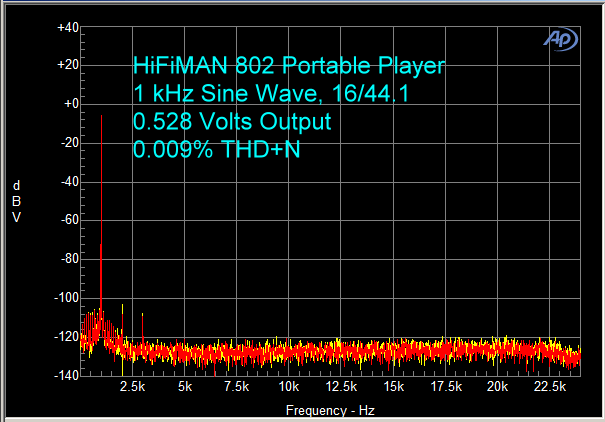
Using 19 kHz and 20 kHz test tones, there were only seven side bands (adjacent to the test tone peaks), and the B-1 Peak at 1 kHz was buried in the noise floor. There were some anomalous peaks at 25 kHz and above.
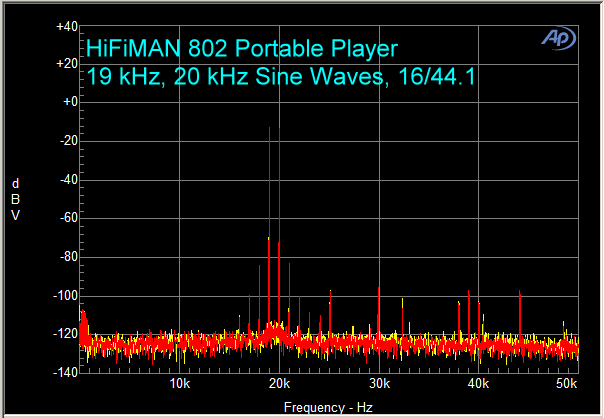
IMD was 0.01%. Notice the lack of side bands around the 7 kHz test tone peak. This means you get excellent musical detail resolution. Notice also the very small second and third ordered harmonics at 14 kHz and 21 kHz.
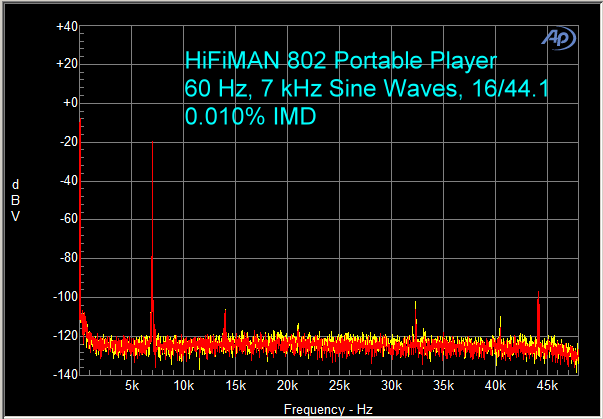
The measured frequency response was 10 Hz - 20 kHz, - 1.5 dB. This means a laid back high end. Rolling off the high frequencies in high end portable music players and headphone amplifiers may be a trend, because it will help protect consumers' hearing, as well as sound like you are listening to speakers in a room, because with speakers, the high frequencies roll off before the lows at your sitting position, so the rolled off high frequency design creats a listening experience like you would have with speakers and sitting across the room.
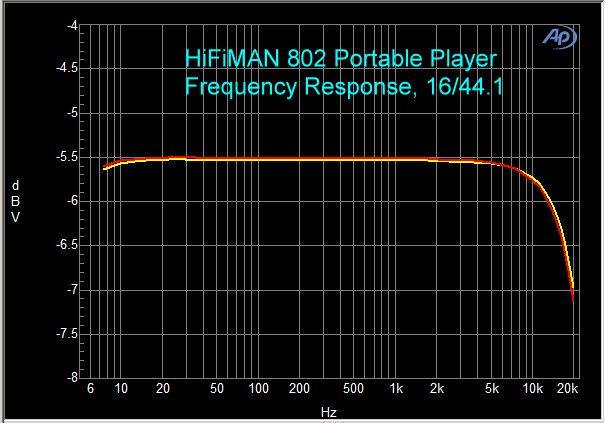
The last set of graphs are with 24/192 sampling.
At 1 kHz, distortion dropped to 0.009%.
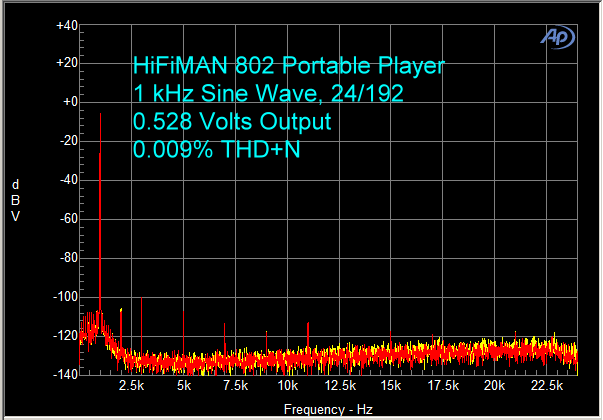
With the 19 kHz, 20 kHz test tones. there were six side bands, and the B-A peak at 1 kHz was again buried in the noise floor.
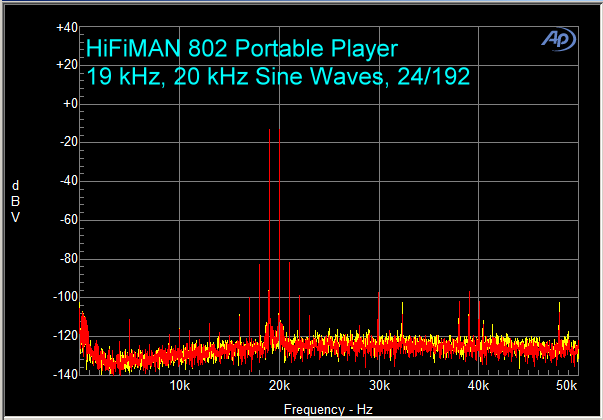
IMD at 24/192 sampling was 0.009%.
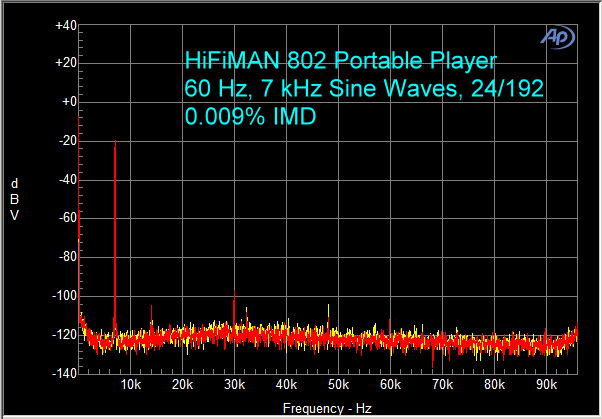
The measured frequency response did not change at the high sampling rate. So, the player is set at this curve, regardless of the sampling frequency of the music being played. However, note that obtaining a high frequency response is not the sole purpose of using high sampling frequencies. The audible band improves as well because of the increased number of samples for the DAC to work with. I have spoken with several digital music engineers, and one said that problems occur in the 3 kHz region and that the sound begins deteriorating at 10 kHz with 16/44.1 sampling. At 20 kHz, there are only two samples to work with, so in a complex sound, like a symphony orchestra, the DAC has to extract a 20 kHz sound from a signal containing hundreds of frequencies. With 24/192 sampling, a 20 kHz sound has nine samples to work with.
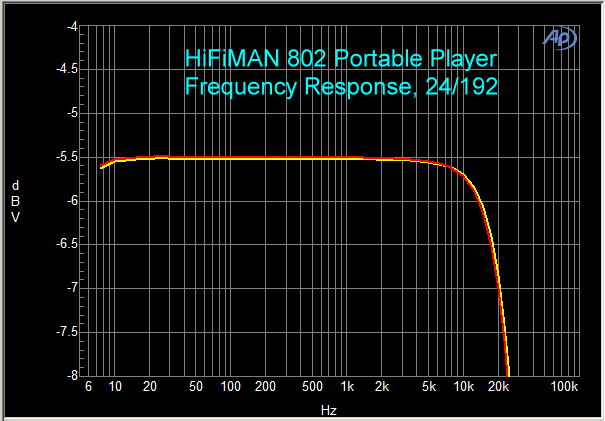
The HiFiMAN HM-802 is a great little player. It is a wonderful alternative to other more ubiquitous players out there, because you can use a full sized pair of headphones, and you can play high resolution music files. The sound is very clear, detailed, deep bass, and low distortion.
Again, I will append the review when I install the balanced amplifier card.